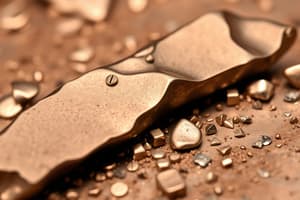Podcast
Questions and Answers
Chalcopyrite is extracted using the Froth Floatation Method.
Chalcopyrite is extracted using the Froth Floatation Method.
True (A)
Copper Pyrite undergoes leaching as part of its extraction.
Copper Pyrite undergoes leaching as part of its extraction.
False (B)
In the partial roasting process, Copper(II) Sulfide is produced from Copper(I) Sulfide.
In the partial roasting process, Copper(II) Sulfide is produced from Copper(I) Sulfide.
False (B)
Blister Copper is produced alongside copper matte during the refining process.
Blister Copper is produced alongside copper matte during the refining process.
The electrolytic refining process primarily improves the quality of crude copper by removing impurities.
The electrolytic refining process primarily improves the quality of crude copper by removing impurities.
Flashcards are hidden until you start studying
Study Notes
Copper Metallurgy Overview
- Key copper ores include Copper Pyrite, Chalcopyrite, Bornite, Chalcocite, Enargite, Covellite, and Cu2S.
- Hyd-washing and magnetic separation are essential techniques for processing copper ores.
No Leaching or Oxidation
- Cu2S reacts with SO2 to produce Cu2O, a crucial step in copper processing.
- Copper's non-leaching and oxidation protection are vital for maintaining purity during extraction.
Partial Roasting Process
- The reaction CuFeS2 + O2 produces Cu2S, FeS, and SO2, significant for sulfur recovery.
- FeS can be oxidized to FeO through reaction with O2.
- A further oxidation of CuFeS2 yields Cu2S, FeO, and SO2, enhancing extraction efficiency.
Reverberatory Furnace Operations
- Slag formation occurs via the reaction of FeS with SiO2, producing FeSiO3.
- Self-reduction in the furnace involves Cu2S reacting with O2 to form Cu2O and SO2.
- High temperatures facilitate the reaction FeO + SiO2 → FeSiO3, producing slag and refining impurities.
Blister Copper Production
- Cu + SiO2 interaction leads to the generation of copper and slag.
- Copper mate consists of a mixture of Cu2S and FeS, critical to the refining process.
- Crude copper is obtained through simultaneous separation of copper mate using slag.
- Electrolytic refining is employed to purify crude copper by removing impurities.
Cost Implications
- The described metallurgy processes are recognized for their expense, impacting the overall economic feasibility of copper extraction.
Studying That Suits You
Use AI to generate personalized quizzes and flashcards to suit your learning preferences.




